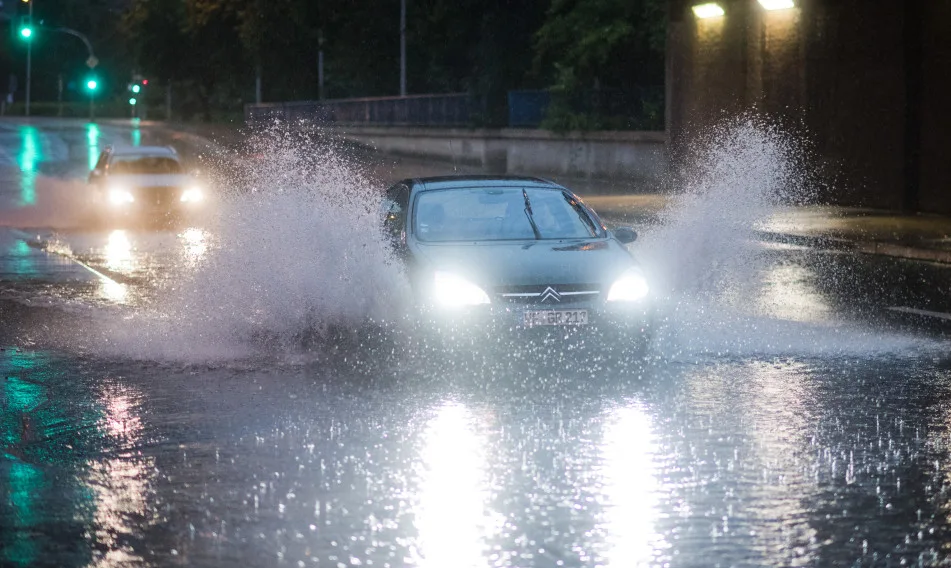
Stay focused: How to drive safer in storms
If you're driving in heavy windy, powerful gusts can jolt you around, with some vehicles particularly at risk. As a driver, there are several ways you can make your trip safer - but there may also be times when it would be better to postpone your journey and stay home.
Berlin (dpa) — Howling wind, the car shaking from left to right and lashing rain while the windscreen wipers are at top speed: Storms can be frightening.
If you're driving, stormy weather requires your full attention and different measures to normal conditions.
For one thing, keep both hands on the wheel at all times, even more than usual, says ADAC, Europe’s largest motoring association.
That’s because a sudden gust of wind can pull the car one way or the other and you need to be ready to steer back on track.

How deep a car can generally drive through water without being damaged is known as the fording depth. For normal passenger cars and most SUVs, that's a maximum of 20 to 40 centimetres (200-400 mm), according to ADAC. (Source: Julian Stratenschulte/dpa/dpa-tmn)
Steer gently, as if you pull too hard on the steering wheel to counteract the wind, you risk an accident if the gust stops abruptly. If that happens and you steered too hard, you could wind up in the ditch or the opposite lane.
It’s easier to react to a steady crosswind than to sudden gusts from different directions. To see which direction the wind is coming from, look at the trees and bushes along your route.
Speed makes a difference
The slower you drive, the better you can react. If a 70 km/h gust hits a car travelling at 100 km/h, the car can be displaced by one metre, according to a German expert bureau.
If the car is travelling at 130 km/h, the displacement can be as much as four metres.
The same tips also apply to motorcyclists. If possible, motorcyclists should stay in the middle of the road so that they have more room to steer on both sides.
Plus, you are better off not wearing clothing that flutters. Wear something that fits tightly to the body instead, the ADAC recommends.
Streamline your luggage, too, as any attachments such as tank bags or luggage rolls give the wind a larger surface to attack.
The perils posed by strong winds increase in open areas, for example on bridges or forest roads or at tunnel exits.
Overtaking large vehicles such as buses and trucks can also be dangerous once your car moves out of their slipstream.
Trailers can be a hazard
High-sided vehicles such as motor homes and delivery vans are more sensitive to wind and in the worst case scenario can even tip over.
Watch out with trailers, too. "Anyone who notices that the trailer is getting unsteady should immediately reduce their speed and brake while observing the traffic behind," says Vincenzo Lucà of the German advisory bureau. "That should restore stability.”
SEE IT: TRUCK-TIPPING WINDS NEARLY TURN DISASTROUS
The surface area that the wind can strike is also increased by items such as roof boxes or roof-mounted bicycles.
If storms are forecast, avoid tree-lined routes. Start being extra careful with winds any stronger than force 5 (29 to 38 km/h). If forecasters predict severe storms (from wind force 10) or even hurricanes, the ADAC advises that you don’t drive at all.
If in doubt, look for a safe rest area
If you find yourself caught suddenly in windy conditions "stop at the nearest possible safe place," Lucà says. Avoid parking in places where there is a risk of danger from falling branches or trees.
The safest place to park your car during a storm is in a garage. If you don’t have one of your own, it’s worth paying to park in one for the duration of the storm.
"This costs comparatively little money, but the car will not be damaged," Lucà says.
When flood follows storm
Sometimes storms are accompanied by heavy rain. If that's the case and the road is flooded, it’s best to drive around the flooded area if you can’t tell how deep the water is. After all, getting water into the engine can cause serious damage.
How deep a car can generally drive through water without being damaged is known as the fording depth. For normal passenger cars and most SUVs, that's a maximum of 20 to 40 centimetres, according to ADAC.
WATCH BELOW: WHAT TO DO IF YOU'RE TRAPPED IN YOUR VEHICLE OR HOME AS FLOODWATERS RISE
Even then, the rule is to drive no faster than walking speed. A good indication of a critical depth is when the water reaches the level of the door sill.
Reporting by: Peter Löschinger in Berlin. Editing by: Allison Williams










